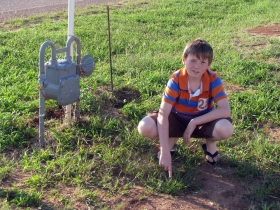
© Amarillo.com
New Deal - Discovering something out of this world was something the Smith family thought was only possible in movies and TV shows.
No burning rocks came crashing from the sky in this case - instead, Todd Smith happened to spot an odd-looking rock while he was mowing his front yard in June. The rock was partially buried in the ground near the gas meter, located a few feet from the roadway.
At first, he kept mowing, but since Todd and his family had seen the "Meteorite Men" TV show on the Science Channel, he said, he decided to go back and pick up the rock. As soon as he held it in his hand, he noticed it was not a typical rock.
"The weight of it was just wrong. That was the first thing that stood out to me," Todd said. "It crossed my mind that it could be (a meteorite) based on how it looked and all and how heavy it was. I thought it was probably a piece of iron."
He showed the rock to his 12-year-old son, Payton, and told him to find tests online to determine if the golf ball-size rock was a meteorite. Roughly 30 minutes later, Payton believed they did have their very own piece of a meteor after using tests he found on the Internet, such as checking the rock magnetism and slicing the rock open.
"I looked at it and thought: think of the odds. How could it be a meteorite here on the front yard?" Payton said.
Even Todd's wife, Lena, expressed her surprise at her husband's remarkable find and ability to differentiate a meteorite from other rocks. But she soon discovered it was no ordinary rock when Todd cut it open and revealed what she said looked like "chrome pieces" sparkling inside the meteorite's core.
On Aug. 25, the Smiths learned their unusual rock was an official meteorite, according to Alan Rubin of the Institute of Geophysics and Planetary Physics at the University of California in Los Angeles.
After conducting their home tests, Todd sent about 20 e-mails to meteorite experts nationwide and received a response from Rubin, who would analyze the rock immediately in his lab.
The meteorite was officially named the "New Deal Meteorite" and classified as an H6 ordinary chondrite - one of 3,889 approved meteorites with that classification, according to the U.S. Geological Society Meteoritical Bulletin Database.
The meteorite probably fell a long time ago, Todd said, based on how weathered it was.
Todd also enlisted the help of Anne Black, vice president of the International Meteorite Collectors Association, to get the meteorite sliced into pieces for his family and for the New Deal ISD science department. He said the slices are still being cut and polished, but they should be ready by next week.
Since it was found in New Deal, Todd said he wanted the school to have its very own piece. Payton said his classmates and teachers are already eager to see the famous rock brought to their school.
The rest of the meteorite will be sold to Texas Christian University through Black and be displayed in its Oscar E. Monnig Meteorite Gallery.
Arthur Ehlmann, former curator of the Monnig gallery and emeritus professor of geology at TCU, said H6 is one of the less common of the ordinary chondrites - that classification is based on the meteorite's chemical composition and texture.
Although the Texas High Plains has produced many meteorites in the past in Plainview and Lubbock, Ehlmann said the New Deal Meteorite was "uniquely different" from the others in the region.
The Lubbock Meteorite, an L5 classification, was found in 1938.
The New Deal Meteorite will be displayed in the recent acquisitions exhibit at the Monnig gallery, which boasts a collection of 1,640 meteorites from around the world.
Since that day in June, Payton still walks around his front yard when he gets home from school, searching for another meteorite.
Todd was not so sure there would be another piece so close to the other, but at this point, they know anything is possible.
"It's one of 297 (meteorites) in Texas, so they're pretty rare to find," Todd said. "I mean, it really is; it's just not normal."
Reader Comments
to our Newsletter